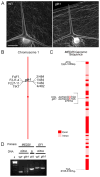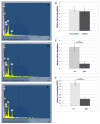Papillae formation on trichome cell walls requires the function of the mediator complex subunit Med25
- PMID: 28889249
- PMCID: PMC6082409
- DOI: 10.1007/s11103-017-0657-x
Papillae formation on trichome cell walls requires the function of the mediator complex subunit Med25
Abstract
Glassy Hair 1 (GLH1) gene that promotes papillae formation on trichome cell walls was identified as a subunit of the transcriptional mediator complex MED25. The MED25 gene is shown to be expressed in trichomes. The expression of the trichome development marker genes GLABRA2 (GL2) and Ethylene Receptor2 (ETR2) is not affected in the glh1 mutant. Presented data suggest that Arabidopsis MED25 mediator component is likely involved in the transcription of genes promoting papillae deposition in trichomes. The plant cell wall plays an important role in communication, defense, organization and support. The importance of each of these functions varies by cell type. Specialized cells, such as Arabidopsis trichomes, exhibit distinct cell wall characteristics including papillae. To better understand the molecular processes important for papillae deposition on the cell wall surface, we identified the GLASSY HAIR 1 (GLH1) gene, which is necessary for papillae formation. We found that a splice-site mutation in the component of the transcriptional mediator complex MED25 gene is responsible for the near papillae-less phenotype of the glh1 mutant. The MED25 gene is expressed in trichomes. Reporters for trichome developmental marker genes GLABRA2 (GL2) and Ethylene Receptor2 (ETR2) were not affected in the glh1 mutant. Collectively, the presented results show that MED25 is necessary for papillae formation on the cell wall surface of leaf trichomes and suggest that the Arabidopsis MED25 mediator component is likely involved in the transcription of a subset of genes that promote papillae deposition in trichomes.
Keywords: Cell wall; Mediator; Papillae; Trichomes.
Figures





Similar articles
-
Papillae formation on Arabidopsis leaf trichomes requires the function of Mediator tail subunits 2, 14, 15a, 16, and 25.Planta. 2019 Apr;249(4):1063-1071. doi: 10.1007/s00425-018-3063-y. Epub 2018 Dec 7. Planta. 2019. PMID: 30535640
-
Arabidopsis GLASSY HAIR genes promote trichome papillae development.J Exp Bot. 2013 Nov;64(16):4981-91. doi: 10.1093/jxb/ert287. Epub 2013 Sep 7. J Exp Bot. 2013. PMID: 24014871 Free PMC article.
-
MEDIATOR25 acts as an integrative hub for the regulation of jasmonate-responsive gene expression in Arabidopsis.Plant Physiol. 2012 Sep;160(1):541-55. doi: 10.1104/pp.112.202697. Epub 2012 Jul 22. Plant Physiol. 2012. PMID: 22822211 Free PMC article.
-
GLABRA2, A Common Regulator for Epidermal Cell Fate Determination and Anthocyanin Biosynthesis in Arabidopsis.Int J Mol Sci. 2019 Oct 9;20(20):4997. doi: 10.3390/ijms20204997. Int J Mol Sci. 2019. PMID: 31601032 Free PMC article. Review.
-
Pathways for epidermal cell differentiation via the homeobox gene GLABRA2: update on the roles of the classic regulator.J Integr Plant Biol. 2012 Oct;54(10):729-37. doi: 10.1111/j.1744-7909.2012.01159.x. J Integr Plant Biol. 2012. PMID: 22943441 Review.
Cited by
-
Small Papillae Regulated by SPD25 are Critical for Balancing Photosynthetic CO2 Assimilation and Water Loss in Rice.Rice (N Y). 2023 Dec 13;16(1):58. doi: 10.1186/s12284-023-00676-7. Rice (N Y). 2023. PMID: 38087150 Free PMC article.
-
Papillae formation on Arabidopsis leaf trichomes requires the function of Mediator tail subunits 2, 14, 15a, 16, and 25.Planta. 2019 Apr;249(4):1063-1071. doi: 10.1007/s00425-018-3063-y. Epub 2018 Dec 7. Planta. 2019. PMID: 30535640
-
Genetic and molecular analysis of trichome development in Arabis alpina.Proc Natl Acad Sci U S A. 2019 Jun 11;116(24):12078-12083. doi: 10.1073/pnas.1819440116. Epub 2019 May 23. Proc Natl Acad Sci U S A. 2019. PMID: 31123146 Free PMC article.
References
-
- Bäckström S, Elfving N, Nilsson R, Wingsle G, Björklund S. Purification of a plant mediator from Arabidopsis thaliana identifies PFT1 as the MED25 subunit. Mol Cell. 2007;26:717–729. - PubMed
-
- Barneche F, Steinmetz F, Echeverría M. Fibrillarin genes encode both a conserved nucleolar protein and a novel small nucleolar RNA involved in ribosomal RNA methylation in Arabidopsis thaliana. J Biol Chem. 2000;275:27212–27220. - PubMed
-
- Betancur L, Singh B, Rapp RA, Wendel JF, Marks MD, Roberts AW, Haigler CH. Phylogenetically distinct cellulose synthase genes support secondary cell wall thickening in Arabidopsis shoot trichomes and cotton fiber. J Integr Plant Biol. 2010;52:205–220. - PubMed
MeSH terms
Substances
Grants and funding
LinkOut - more resources
Full Text Sources
Other Literature Sources
Molecular Biology Databases

